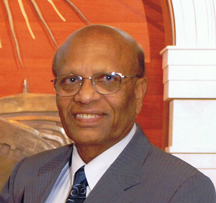More than 2500 years ago, Bhagwan Mahavir shared the following reflection, saying, “There is nothing so small and subtle as the atom or any element as vast as space. Similarly, there is no quality of soul more subtle than non-violence and no virtue of spirit greater than reverence for life.” Ahimsa is a principle that Jains should teach and practice, not only towards human beings, but also towards all creatures.
The teachings of ahimsa refer not only to wars and visible physical acts of violence, but also to the violence in the hearts and minds of human beings, their lack of concern and compassion for their fellow human beings and for the natural world. Ancient Jain texts explain that violence is not defined by actual harm only, for this may be unintentional. It is the intention to harm, the absence of compassion that makes action violent. Without violent thought there could be no violent actions. When violence enters our thoughts, we should remember, “You are that which you intend to hurt, injure, insult, torment, persecute, torture, enslave or kill.”
People all over the world today admire (and many follow) ahimsa. Some equate the unconditional ahimsa of the Jains to the true or real democracy of existence of all living beings in this universe.
In the twentieth century, the most vibrant and illustrious example of Jain influence was that of Mahatma Gandhi, acclaimed as the Father of the free Indian Nation. Gandhi-ji’s Spiritual mentor and friend, Shrimad Räjchandra, was a Jain. The two great men corresponded, until Räjchandra’s death, on issues of faith and ethics. The central Jain teaching of ahimsa was the guiding principle of Gandhi’s civil disobedience in the cause of freedom and social equality. His ecological philosophy found apt expression in his observation that the greatest work of humanity could not match the smallest wonder of nature.
Jains inspired Mahatma Gandhi, who in turn inspired millions - including many Nobel Peace Laureates - to the philosophy of non-violence. It was a non-Jain (Gandhi-ji) who made the ahimsa of the Jains a household and respectable word, not just in India, but throughout the world. He took the Ahimsa of Jains from textbooks and from the Sadhus, and gave it to the most common men and women. This Practical Ahimsa made Gandhi-ji a role model for millions of people around the world. In 2007, the United Nations established October 2 as an International Day of Non-Violence in honor of the birthday of Mahatma Gandhi.
And yet, we have no Jain Gandhis, no Jain Peace Laureates. What does this tell us? To me, it appears that although we Jains inherited ahimsa as a rich gift, we seem not to care enough for this treasure. We have allowed ahimsa to become merely a slogan instead of shaping it into wider and broader practice.
An Ahimsa Crisis: You Decide: Ahimsa: Just A Slogan?
Author:
 Dr. Sulekh Chand Jain
Dr. Sulekh Chand Jain
 Dr. Sulekh Chand Jain
Dr. Sulekh Chand Jain
Published: 05.09.2016
Sources
 Title: An Ahimsa Crisis You Decide
Title: An Ahimsa Crisis You DecideAuthor: Sulekh C. Jain
Edition: 2016, 1st edition
Publisher: Prakrit Bharati Academy, Jaipur, India
Page glossary
Some texts contain footnotes and glossary entries. To distinguish between them, the links have different colors.
Page statistics
This page has been viewed 745 times.